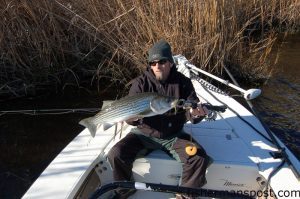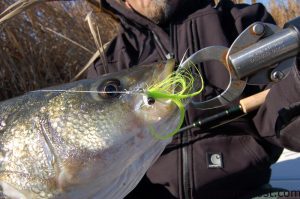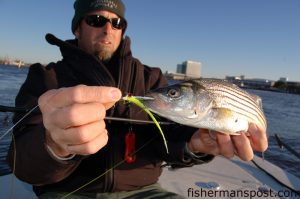Cape Fear On The Fly – Earning Your Stripes

Capt. Jon Huff, of Circle H Charters, with a 7 lb. striper caught in the Cape Fear River on the fly. He was working a bank using a sinking line and a chartreuse and white Clouser.
When Gary Hurley and I first discussed the Cape Fear on the Fly Series at the beginning of this year, I already knew that our local striped bass would probably be the most difficult species to catch on the fly. The Cape Fear striper would definitely be a lofty goal to try and accomplish.
Stripers in the Cape Fear River and its tributaries are an inconsistent fishery to say the least. Historically, the Cape Fear River served as a major spawning river for the striped bass, and various factors, including the construction of three locks and dams, have caused a drastic decline of our local striper population over the years.
Organizations such as Cape Fear River Watch are helping to promote awareness of this problem and even spearheading a project to build rock weirs (or ladders) to help spawning stripers traverse the locks and dams on their way to historical spawning grounds up the Cape Fear River.
Also, the North Carolina Wildlife Commission is operating an impressive stocking program with local brood stock and introduced over 100,000 fingerlings into the Cape Fear River last winter. However, with striper stocks at ten percent of their historical levels, there is a lot of work to be done.
That being said, there are still stripers in the river, and they can be caught with a little luck and time on the water.
Gary and I were unable to get together at the end of last season, but I did manage to get out on the Cape Fear River late last winter with a friend and a fly rod, and we did have a few bites on the fly. Although we did not land any fish, I did learn a few things and was able to put them to use when Gary and I scheduled our one day to chase stripers on the fly.
Murphy’s Law had our day start out cold and very windy. With the warm temperatures we had been having just a few days earlier, the cold was a bit of a shock. And the twenty knot winds were not helping our confidence levels any, but we decided to give it a shot anyway.
After some foot dragging at the boat ramp downtown, we were finally running upriver to our first spot, which did afford us some protection from the wind. Gary stepped on the bow of my skiff and started stripping line into my casting bucket, as I positioned the boat with my remote controlled trolling motor to give him the best shot to cast and work a fly through the target area.
He was using his Rodman custom 8wt fly rod and the same Rio Outbound full sinking line that we used to catch speckled trout on our last trip, though we did beef up the leader to a 20 lb. tippet. Tied to the end we started off with a chartreuse and white Clouser Minnow in a 2/0 size.

A close-up of the Clouser Minnow that helped Capt. Jon Huff, of Circle H Charters, land two stripers on a falling tide in the Cape Fear River above downtown Wilmington.
After some warm up casts and some suggestions from his casting coach (yours truly), Gary was working the Clouser through a spot that had held some fish previously on a similar tide. My plan was to work spots that would offer some protection from the wind, allow us to hold position with the trolling motor, and most importantly, had held fish and produced bites before.
I had some luck in this first spot earlier in the month with smaller school sized fish (2-5 lbs.) and hoped it would produce a few bites. It wasn’t long before we saw a fish boil on the surface close to the bank and that was more than enough to get us excited and give us some real hope.
Gary made dozens of casts towards the bank and then retrieved the fly with a short erratic stripping motion while it swept down current. None of his casts were answered with a striper tug, so he handed over the rod to me and manned the remote. After only a couple of casts doing exactly the same as Gary had, the Fish Gods smiled upon us and I was tight to a first fish. It turned out to be a scrappy 14” striper, but a much anticipated first striper on the fly for me. And it was a relief to know that we had, at least, accomplished our goal!
Gary and I switched places again, and he continued the cast, sweep, retrieve pattern through our first spot hoping the bite would turn on and we could catch a few more fish and maybe even some bigger ones. We fished this spot longer than I normally would have, hoping for another bite that never came, but then decided to run further upriver with high hopes of catching a bigger fish.
The day was actually getting nicer with the winds letting up and the temperature climbing. This made the run further up the river not too unpleasant. I decided to try and fish a bank that had produced a few bites in the previous month, but I could not find a good angle to position the boat to present a good cast, as the wind ended up blowing onto Gary’s casting shoulder.
With the wind blowing on his shoulder, the line and fly (with a sharp hook) were getting blown too close to Gary and we quickly abandoned this strategy. I decided to try a bank more protected from the wind, and as I trolling motored to our new spot I checked in with my friend Jamie Rushing of Seagate Charters, who was on the water that morning and always has good information regarding stripers.
It turned out that Jamie had caught a few stripers that morning (as well as an upper slot red drum), and as I wished Jamie “good luck” and hung up the phone, I caught a splash out of the corner of my eye. I pointed the trolling motor towards the splash and searched for any more action in the area. To my surprise, I suddenly saw stripers in multiple pods of two and three crash the surface savagely attacking bait.
I yelled at Gary to get ready and put on his game face while I was unsuccessfully trying to stay calm, as I had never seen such action with Cape Fear stripers before. They looked more like false albacore blitzing on top. We managed to maneuver into the middle of the melee, but the fish were really on the move and presenting the fly to a pod of feeding fish proved difficult, and throwing a full sinking line at distance to moving fish, all the while changing angles, is no easy task.
Gary handed me the rod after numerous casts with no luck, and I managed to tangle the line around everything and anything while trying to get the fly in front of the still very active fish. After what seemed like an hour, but was more likely mere minutes, the action slowed and we were both amazed at what we had just witnessed. As Gary positioned me to cast at some bait that was acting nervous against the bank, the cards fell in our favor again.

The first striper of the day caught on the fly--a 14" striped bass caught on the lee end of a point near downtown Wilmington.
After one or two strips, I was tight to a nice fish. I played this striper gingerly as it put a deep bend in Gary’s 8wt and pulled short bursts of line through my fingers. He was hooked solidly, though, and in a couple of minutes we had the 7 lb. striper in the net.
We were elated at our good fortune, and after a short photo shoot the only thing we could think of to top the morning would be to catch Gary a striper on the fly. But after at least another hour and a half of casting with no bites and Gary’s casting arm threatening tendonitis, we decided to call it a day.
I don’t know if I will ever see action again like we did on the Cape Fear that day, but I have seen it dozens of times over in my mind. And I can guarantee you that it will keep me chasing our local striped bass population and hoping for a time when stripers feeding on the surface in sizable schools is commonplace on the Cape Fear River.
Thanks for reading, and as always, come on down to Intracoastal Angler with any questions about fly fishing for stripers, or anything else for that matter, and I will be glad to answer them for you.
Tight Loops,
Jon Huff
Capt. Jon Huff is owner operator of Circle H Charters, an inshore fly and light tackle guide service based out of Wrightsville Beach. Jon splits his time between running inshore charters, fishing offshore tournaments, and co-managing Intracoastal Angler. (910) 617-2619, www.circlehcharters.com
